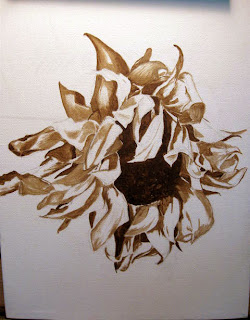Howdy. Ok. So, basically the next step, once our drawing is as correct as it can be is to tone it with raw umber. I like Windsor and Newton raw umber, but brand is really just about preference so...whatever you like and/or can afford.
Anyhoo. What we want to do now is paint our subject in a monochrome value study. If you need help seeing the values, a sheet of red acetate (available at most craft stores) will help. the red takes the color away and you can easily see what's lighter or darker. It can be deceiving. Our bastard left-brain wants to say that green is always 'darker' than the yellow, but that's not the case. Really look at the petals and leaves. Is that petal darker or lighter in VALUE than the leaf? Your lightest value can really be left white....or you can paint it white. Doesn't matter and sometimes I do one and sometimes the other.
The other thing to consider at this stage is what's the dealy-o with the background? The funktified table that's in the picture could work, but...maybe put it on cloth, or wood...you're the artist. Make it up. I'm pretty partial to the wood fading to infinity blackness like the old masters, but in this case I decided to go with a sort of non-descript red background. I'm ahead of myself, but you need to give it some consideration because depending what you want to do with the background, you may want to include the background in your value study. Especially if the darkness of the background effects the shadowing etc of your subject.
So, here we go. Here's my umber study.
Now, I did include the shadow under the flower but I really didn't give the background much attention. It certain effects the final outcome, so...now's the time to make the decision.
Just like in the last stage, take your time. Watch your edges. Think about what you're painting. It's leaves and petals. No surface is perfectly horizontal or vertical. So don't paint that way. Don't just paint back and forth, follow the form of the thing you are painting. That's always true. It doesn't matter if it's a child's face, an apple, rough tree bark or a flower petal. Think about how your hand would trace over that surface and let your brush follow that path. I see so many students paint animals, like their cat and they paint the fur UP DOWN UP DOWN. That cat would scratch your face off it you pet it that way. The fur follows the contours of the body. so should your brushstrokes.
Ok...have at it.

No comments:
Post a Comment